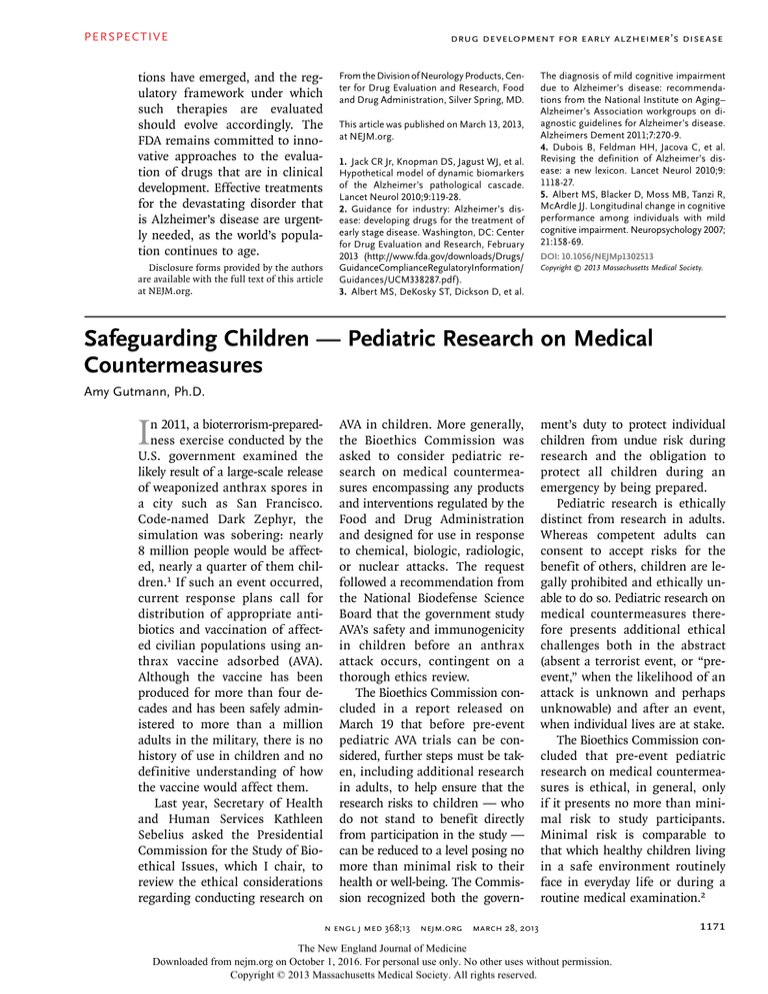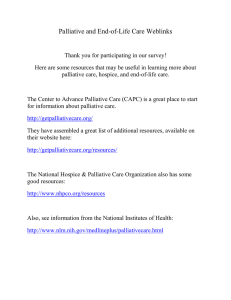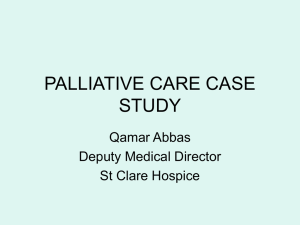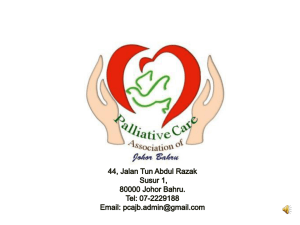
PERSPECTIVE
tions have emerged, and the regulatory framework under which
such therapies are evaluated
should evolve accordingly. The
FDA remains committed to innovative approaches to the evaluation of drugs that are in clinical
development. Effective treatments
for the devastating disorder that
is Alzheimer’s disease are urgently needed, as the world’s population continues to age.
Disclosure forms provided by the authors
are available with the full text of this article
at NEJM.org.
Drug Development for Early Alzheimer’s Disease
From the Division of Neurology Products, Center for Drug Evaluation and Research, Food
and Drug Administration, Silver Spring, MD.
This article was published on March 13, 2013,
at NEJM.org.
1. Jack CR Jr, Knopman DS, Jagust WJ, et al.
Hypothetical model of dynamic biomarkers
of the Alzheimer’s pathological cascade.
Lancet Neurol 2010;9:119-28.
2. Guidance for industry: Alzheimer’s disease: developing drugs for the treatment of
early stage disease. Washington, DC: Center
for Drug Evaluation and Research, February
2013 (http://www.fda.gov/downloads/Drugs/
GuidanceComplianceRegulatoryInformation/
Guidances/UCM338287.pdf).
3. Albert MS, DeKosky ST, Dickson D, et al.
The diagnosis of mild cognitive impairment
due to Alzheimer’s disease: recommendations from the National Institute on Aging–
Alzheimer’s Association workgroups on diagnostic guidelines for Alzheimer’s disease.
Alzheimers Dement 2011;7:270-9.
4. Dubois B, Feldman HH, Jacova C, et al.
Revising the definition of Alzheimer’s disease: a new lexicon. Lancet Neurol 2010;9:
1118-27.
5. Albert MS, Blacker D, Moss MB, Tanzi R,
McArdle JJ. Longitudinal change in cognitive
performance among individuals with mild
cognitive impairment. Neuropsychology 2007;
21:158-69.
DOI: 10.1056/NEJMp1302513
Copyright © 2013 Massachusetts Medical Society.
Safeguarding Children — Pediatric Research on Medical
Countermeasures
Amy Gutmann, Ph.D.
I
n 2011, a bioterrorism-preparedness exercise conducted by the
U.S. government examined the
likely result of a large-scale release
of weaponized anthrax spores in
a city such as San Francisco.
Code-named Dark Zephyr, the
simulation was sobering: nearly
8 million people would be affected, nearly a quarter of them children.1 If such an event occurred,
current response plans call for
distribution of appropriate antibiotics and vaccination of affected civilian populations using anthrax vaccine adsorbed (AVA).
Although the vaccine has been
produced for more than four de­
cades and has been safely administered to more than a million
adults in the military, there is no
history of use in children and no
definitive understanding of how
the vaccine would affect them.
Last year, Secretary of Health
and Human Services Kathleen
Sebelius asked the Presidential
Commission for the Study of Bioethical Issues, which I chair, to
review the ethical considerations
regarding conducting research on
AVA in children. More generally,
the Bioethics Commission was
asked to consider pediatric research on medical countermeasures encompassing any products
and interventions regulated by the
Food and Drug Administration
and designed for use in response
to chemical, biologic, radiologic,
or nuclear attacks. The request
followed a recommendation from
the National Biodefense Science
Board that the government study
AVA’s safety and immunogenicity
in children before an anthrax
attack occurs, contingent on a
thorough ethics review.
The Bioethics Commission concluded in a report released on
March 19 that before pre-event
pediatric AVA trials can be considered, further steps must be taken, including additional research
in adults, to help ensure that the
research risks to children — who
do not stand to benefit directly
from participation in the study —
can be reduced to a level posing no
more than minimal risk to their
health or well-being. The Commission recognized both the govern-
ment’s duty to protect individual
children from undue risk during
research and the obligation to
protect all children during an
emergency by being prepared.
Pediatric research is ethically
distinct from research in adults.
Whereas competent adults can
consent to accept risks for the
benefit of others, children are legally prohibited and ethically unable to do so. Pediatric research on
medical countermeasures therefore presents additional ethical
challenges both in the abstract
(absent a terrorist event, or “preevent,” when the likelihood of an
attack is unknown and perhaps
unknowable) and after an event,
when individual lives are at stake.
The Bioethics Commission concluded that pre-event pediatric
research on medical countermeasures is ethical, in general, only
if it presents no more than minimal risk to study participants.
Minimal risk is comparable to
that which healthy children living
in a safe environment routinely
face in everyday life or during a
routine medical examination.2
n engl j med 368;13 nejm.org march 28, 2013
The New England Journal of Medicine
Downloaded from nejm.org on October 1, 2016. For personal use only. No other uses without permission.
Copyright © 2013 Massachusetts Medical Society. All rights reserved.
1171
PERSPE C T I V E
Pediatric Research on Medical Countermeasures
This conclusion, which seeks to
limit research risk to individual
child participants, emanates from
consideration of three characteristics of such research that challenge traditional research ethics:
the research involves the potential
treatment or prevention of a highly disabling or lethal condition
that no one has yet contracted; it
aims to determine how best to
treat a condition resulting from
an event whose likelihood of occurring is unknown; and though
the knowledge gained could be
useful for future treatment, we
hope never to have occasion to
use it.
To be ethical, research involving children must generally pose
no greater than minimal risk to
participants unless the research
presents the prospect of direct
benefit. A minor increase over
minimal risk — which is still very
limited and poses no substantial
risk to health or well-being — is
permissible only when research
is likely to yield generalizable
knowledge about participants’ specific condition. It may also be permissible, with extensive nationallevel review, under exceptional
circumstances outlined in Title
45 of the Code of Federal Regulations (45 CFR §46.407 [2012],
referred to as Section 407).3
Pre-event studies of a medical
countermeasure cannot directly
benefit participants, who are not
affected by the condition it is designed to treat. Furthermore, only
when unusual circumstances prohibit completing such testing in
consenting adults and developing
a minimal-risk research design
can pre-event research in children
involving “a minor increase over
minimal risk” proceed to nationallevel review. That risk level is defined by only a “narrow” expansion of minimal risk, which still
1172
“poses no significant threat to the
child’s health or well-being.”2,3
Minimal-risk pre-event pediatric testing of medical countermeasures may be made possible
through age-deescalation studies,
which generally entail gradually
lowering the age criterion for participants in a series of studies. To
determine whether such testing
is feasible, prior testing such as
modeling, testing in animals, and
testing in adults must first identify, delineate, and characterize
research risks. Then, if an intervention is shown to pose minimal risk in 18-year-olds, it might
be possible to infer that a study
involving 16- and 17-year-olds
would present only minimal risk.
There might be key points along
the developmental trajectory at
which age is only one of several
factors to consider, depending on
the countermeasure being tested;
for example, groups might have
to be defined by stages of puberty
as well as by age.
In response to the Secretary’s
broader request, the Bioethics
Commission developed a framework for Section 407 review. We
first clarified the circumstances
in which proposed research presents a “reasonable opportunity”
to address a “serious problem.” 3
One threshold condition, for example, is that the research must
be of “vital importance” to addressing that problem.4 Second,
we specified a rigorous set of
conditions that would all need to
be satisfied to justify a determination that the research adhered
to “sound ethical principles.”
These conditions fall into five
categories: an ethical threshold
of acceptable risk and adequate
protection from harm, ethical
study and trial design, post-trial
requirements to ensure ethical
treatment of children and their
families, community engagement,
and transparency and accountability. Finally, the Commission
reiterated the importance of informed parental permission and
meaningful and developmentally
appropriate assent by children.5
The Commission recommends
that reviewers use this framework
when assessing protocols for preevent pediatric research on a
medical countermeasure involving a minor increase over minimal risk without direct benefit,
to ensure thoroughness and ethical rigor. But it should be applied
only in rare circumstances in
which minimal-risk research cannot be designed.
Post-event research on medical countermeasures should also
be limited to minimal risk whenever possible, but since it could
directly benefit participants who
are exposed to a pathogen during
the event, different ethical and
regulatory standards apply. Children exposed to a pathogen could
enroll in research likely to yield
information of vital importance
to elucidating or ameliorating
both their own condition and
that condition generally in other
children.
The Commission recommends
that post-event research be planned
in advance and be conducted
when a relatively untested medical countermeasure is administered to children in an emergency, with health officials collecting
data during the event so we may
learn as much as possible about
use of the countermeasure. Adequate processes must be in place
for informed parental permission
and meaningful assent by children; the research design must
be scientifically sound; enrolled
children must have access to the
best available care; there must be
adequate plans for compensating
n engl j med 368;13 nejm.org march 28, 2013
The New England Journal of Medicine
Downloaded from nejm.org on October 1, 2016. For personal use only. No other uses without permission.
Copyright © 2013 Massachusetts Medical Society. All rights reserved.
PERSPECTIVE
anyone injured by research; and
provisions must be made to engage communities throughout the
course of research.
Routine preexposure prophylaxis in military personnel has
resulted in observational studies
of AVA in young adults, but additional data from adult populations — from dose-sparing studies, for example — are needed
before pediatric testing can be
ethically considered. With additional safety data, the level of
risk to young adults could be inferred with increased statistical
confidence. Such an inference,
in turn, would influence a possible minimal-risk design of a series
of age-deescalating safety and immunogenicity studies.
Pediatric Research on Medical Countermeasures
Sound science must always respect our ethical obligations to
protect children from unnecessary
risks. Medical countermeasure research warrants an ongoing national conversation to ensure an
unwavering commitment to safeguard all children both from unacceptable risks in research and
through research promoting their
health and well-being.
Disclosure forms provided by the author
are available with the full text of this article
at NEJM.org.
From the Presidential Commission for the
Study of Bioethical Issues, Washington,
DC, and the Office of the President and Department of Political Science, University of
Pennsylvania, Philadelphia.
This article was published on March 19, 2013,
at NEJM.org.
1. White R. Anthrax vaccine trials for children: precautionary or premature? Bio­
ethics Forum. May 22, 2012 (http://www
.thehastingscenter.org/Bioethicsforum/Post
.aspx?id=5852).
2. National Commission for the Protection
of Human Subjects of Biomedical and Behavioral Research. Research involving children. Washington, DC: Department of
Health, Education, and Welfare, 1977 (http://
bioethics.georgetown.edu/pcbe/reports/
past_commissions/Research_involving_
children.pdf).
3. Code of Federal Regulations, Title 45,
Public Welfare. Department of Health and
Human Services. Part 46, Protection of human subjects, Section 407.
4. Code of Federal Regulations, Title 45,
Public Welfare. Department of Health and
Human Services. Part 46, Protection of human subjects, Section 406.
5. Presidential Commission for the Study of
Bioethical Issues (PCSBI). Safeguarding children: pediatric medical countermeasure research. Washington, DC: PCSBI, 2013.
DOI: 10.1056/NEJMp1302093
Copyright © 2013 Massachusetts Medical Society.
Generalist plus Specialist Palliative Care — Creating a More
Sustainable Model
Timothy E. Quill, M.D., and Amy P. Abernethy, M.D.
P
alliative care, a medical field
that has been practiced informally for centuries, was recently
granted formal specialty status
by the American Board of Medical Specialties. The demand for
palliative care specialists is growing rapidly, since timely palliative
care consultations have been
shown to improve the quality of
care, reduce overall costs, and
sometimes even increase longevity.1,2 The field grew out of a hospice tradition in which palliative
treatment was delivered only at
the end of life, but its role has
expanded so that palliative care
specialists now also provide palliative treatment in the earlier stages of disease alongside diseasedirected medical care, improving
quality of care and medical decision making regardless of the
stage of illness. In an era when
health care organizations may
soon receive capitated payments
for all services that patients receive, many are investing in palliative care to improve overall value.
Although this trend has fostered rapid growth of the palliative
care specialty, the current model
adds another layer of specialized
care for seriously ill patients on
top of an already complex, expensive health care environment. As
in any medical discipline, some
core elements of palliative care,
such as aligning treatment with
a patient’s goals and basic symptom management, should be routine aspects of care delivered by
any practitioner. Other skills are
more complex and take years of
training to learn and apply, such
as negotiating a difficult family
meeting, addressing veiled existential distress, and managing re-
fractory symptoms. Now that the
value of palliative care has been
recognized, specialists are sometimes called on for all palliative
needs, regardless of complexity.
Although it may theoretically
seem optimal for palliative medicine specialists to take on all palliative aspects of care, this model
has negative consequences. First,
the increasing demand for palliative care will soon outstrip the
supply of providers. Second, many
elements of palliative care can be
provided by existing specialist or
generalist clinicians regardless of
discipline; adding another specialty team to address all suffering
may unintentionally undermine
existing therapeutic relationships.
Third, if palliative care specialists take on all palliative care
tasks, primary care clinicians and
other specialists may begin to be-
n engl j med 368;13 nejm.org march 28, 2013
The New England Journal of Medicine
Downloaded from nejm.org on October 1, 2016. For personal use only. No other uses without permission.
Copyright © 2013 Massachusetts Medical Society. All rights reserved.
1173




